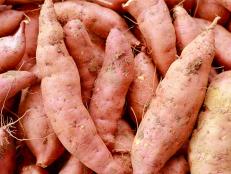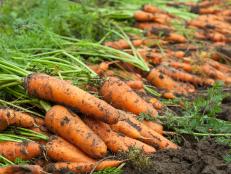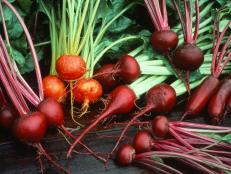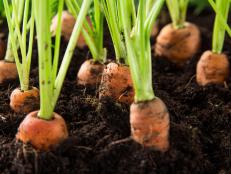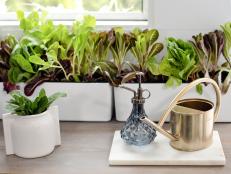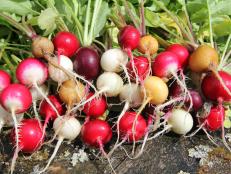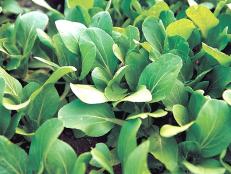Garden to Table: Turnips

Oxana Denezhkina / Shutterstock.com
Asian white globed saladette turnips such as the Hakurei variety are typically sweet with velvety green leaves.
Different strokes for different folks. Turnips can mean very different things depending upon whether you are eating in the North or the South. When folks from the North say, “I’m going to cook turnips for dinner tonight,” they usually mean they’ll be eating the bulbous, juicy root. And when Southerners ponder a “mess of greens,” they’re referring to the turnip’s leaves: the predominately consumed plant part. In the olden days, however, no part of the plant was wasted. So we encourage folks at our farmers’ market to consider the whole plant as a perfect dinner. One can roast the root, quartered, while sautéing, or braising the greens. Then reassemble the whole vegetable into a perfect “nest and eggs,” of turnip roots adorning a cradle of turnip greens. Turnips might be a perfect metaphor for the farmer, who finds his livelihood in both the soil and the sun.
Our experience of turnips is personal: as newbie farmers just learning the ropes we used to watch our first farm boss’s kids pulling one after another out of the ground and grinning as they wiped the dirty root off on the bottoms of their shirts before eating.
One of the oldest foods that we know of, turnips were commonly consumed in imperial Roman times. The turnip is more closely related to mustard greens, rutabagas and an assortment of radishes, and more distantly kin to broccoli, kale, cabbage and Brussels sprouts. The classic proverb states that “you can’t squeeze blood out of a turnip” but we beg to differ. We think turnips are globes of earth energy, crowned by a halo of green to be productive, popular, profitable and full of potential deliciousness. We have particularly fallen in love with the Asian white-globed saladette varieties, such as Hakurei and White Doll, which really outdo themselves in sweetness, and wear some of the most velvety leaves.—Joe and Judith
Varieties Grown
White Doll, Hakurei, Scarlet Ohno Revival, Seven Top Greens
Seed Source
What I’m Wearing
In the subterranean, roots can be white, scarlet, purple-topped, or golden, and leaves come in all shades of green, sometimes with a purple seam.
Tasting Notes
Roots exhibit a wide range of flavor, from candied to sulfured notes, and swollen with juice. Greens faintly resemble their mustard brethren; with a clean and sometimes sharp flavor.
How to Grow
- We start all of our turnips from seed, giving about 4-6” between rows. Turnips can be sown in most places during the whole growing season. Here in the South we typically consider turnip green varieties that grow big leaves but relatively little root, such as Seven Top, to be a fall crop.
- Make sure that your garden plot has good tilth for these taproots to grow by pitchforking to loosen your soil.
- Turnips do not have a high fertility need, but always benefit from the addition of good compost or worm castings.
- The most important consideration with turnips, or any other root vegetable, is to thin these plants thoroughly. For smaller saladette varieties, such as the White Doll, Hakurei, or Scarlet Ohno, we thin plants less vigorously, about 1” between each plant. However for larger, storing turnip types, like Purple Top, we usually thin to 1.5-2” between plants.
- Turnips are susceptible to several insects, including aphids, cabbage eating Lepidopteran larvae, and flea beetles. We find that the flea beetle damage is hardest to control, and in years when these buggers are bad, we use row cover to keep them off of tender leaves.
- We harvest turnips out of the ground, leaves and all, until the continual pulling causes the leaves to tatter. After that, we pull the whole plant and cut off tops to store the roots. Keep in a ventilated plastic bag in the fridge. Stored roots will keep for months.
Turnips hold their own when placed alongside a hearty cut of meat, as with this Herbed Leg of Lamb with Roasted Turnips courtesy of Food Network Magazine. Another stick-to-your-ribs delight, Bobby Flay’s Turkey Pot Pie with Sage Crust incorporates turnips among its medley of veggies. Or how about a hearty Vegetable Shepherd’s Pie from Food Network Magazine loaded up with those succulent root vegetables? Looking for something a little more elegant? You won’t be disappointed by this luxurious Turnip Gratin with Almonds from Food Network Magazine. But don’t stop there. Find these and a variety of other turnip delights at FN Dish.
In this Garden to Table feature, farmer-bloggers Judith Winfrey and Joe Reynolds offer their tips for sowing, growing and harvesting. And then we kick it over to FN Dish for some delicious recipes using this seasonal produce.






